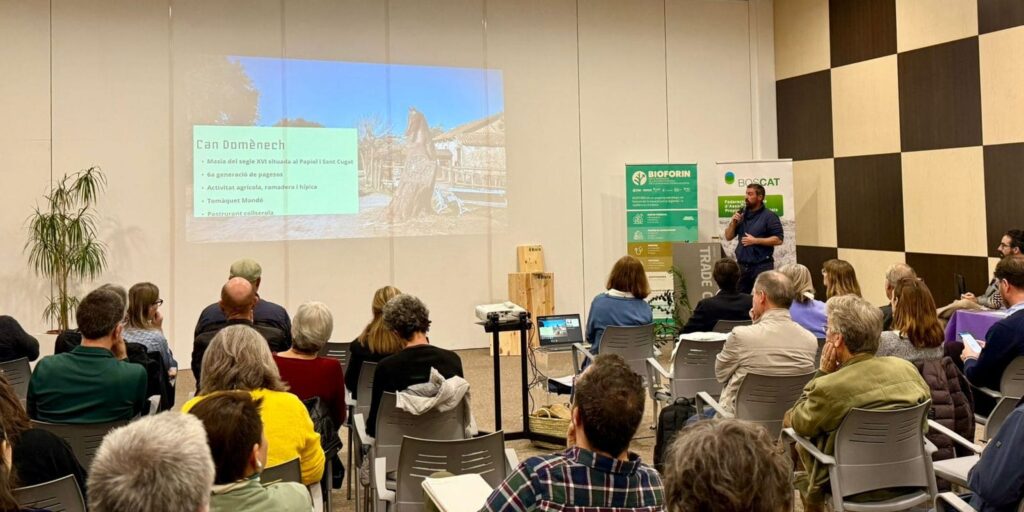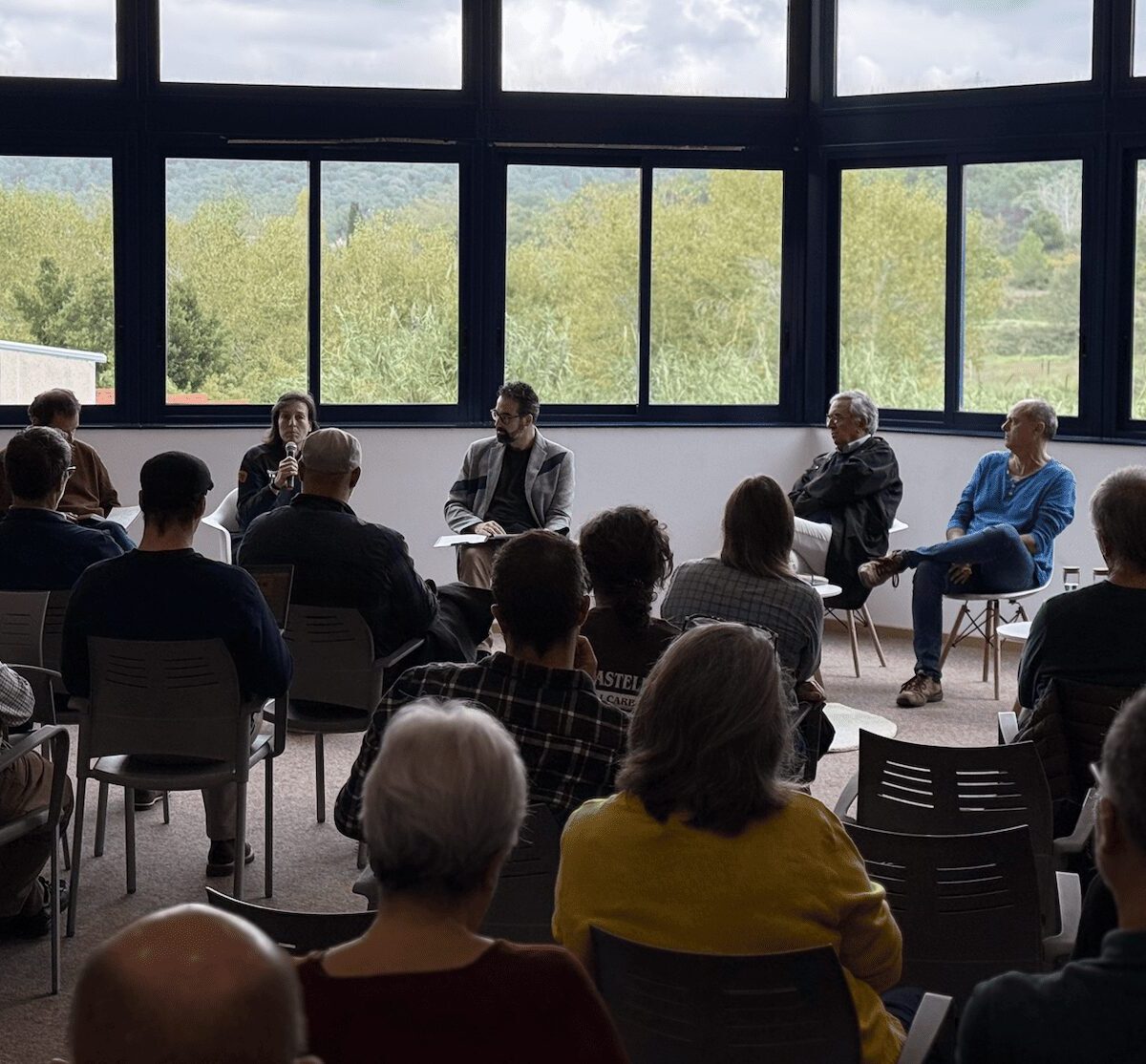This Thursday, 13 November, the SC Trade Center hosted the event The Forest of the Future for the Society of the Future, which brought together nearly fifty participants to discuss bioeconomy, sustainability, forest management, circular economy, and the role of the Collserola forest as an ecological, economic, and social driver.
Organised by several sector entities and public administrations, the event focused on a fundamental question: what future do we want for our forests, and what role do we play as a society in their preservation and enhancement?
The forest, a living and essential resource
Albert Salarich, Councillor for Business and Energy of the Sant Cugat City Council, opened the event by highlighting the role of Collserola as the city’s “green lung” and the need for decisive action to preserve it:
“We have an opportunity for reflection and transformation, especially for the sectors that form part of the circular value chain. More than 1,800 people work within this local and sustainable economy.”
Innovative projects to transform the territory

Throughout the day, projects such as Bioforin were presented, led by the Catalan Bioenergy Cluster (CBC) and introduced by Conrad Pagà. The initiative promotes the use of forest biomass as an energy resource, preventing forest abandonment and prioritising sustainable management, research, and environmental awareness. Pagà highlighted that unmanaged forests represent a risk, as they can lead to wildfires, waste, and pollution.
From BOSCAT, Diana González emphasised that local forests are too dense and suffer from a lack of water and vital space:
“We need to rethink our relationship with the territory and give a second life to these trees. This is a new opportunity for a bioeconomy with human and social roots.”
Natalia Tierno, technician of the regional energy and housing offices of Vallès Occidental, shared the experience of Terrassa, where forest biomass is already used to heat public facilities such as swimming pools. This has generated green employment, reduced emissions (over 20,000 tonnes of CO₂), and improved energy efficiency.
Catalan wood was also highlighted as a structural resource through the testimony of Carles Martí from Grup Boix, which produces cross-laminated timber (CLT) in the Berguedà region. Martí spoke about the potential of local timber to support sustainable construction, create jobs, and naturally store CO₂.
Livestock as a tool for land management
Paul Domènech, from Can Domènech, presented the silvopasture project using donkeys, which helps reduce wildfire risk while maintaining traditional livestock activity in Collserola.
Along the same lines, Teresa Beiges of the Forest Property Centre explained how climate credits can provide a financing mechanism for forest projects with real territorial impact, stressing the need for clear and reliable criteria to ensure quality and transparency.
Round table: “The future of Collserola, between biodiversity, management and society”
The day continued with a round table where various experts debated the future of the Collserola Natural Park in the context of climate change, urban pressure, and the need for active forest management.
Joan Vilamú, Head of Territorial Action of the Collserola Natural Park, noted:
“We are in a critical situation: we have moved from a diverse agricultural landscape to a continuous, homogeneous and poorly managed forest.”
According to Vilamú, this leads to a major loss of biodiversity:
“If we don’t manage the forest, we will end up with only one type of ecosystem and we will lose many species.”
He advocated for recovering open spaces through agriculture and livestock farming and called for stronger public–private collaboration.
Similarly, Manel Ferrer, President of the Collserola Iniciatives Forest Owners Association, shared a family anecdote:
“After the phylloxera crisis, my grandfather went every Thursday to plant pine trees in Collserola; he even took out a loan to do so.”
His message illustrated how forest management has historically been a committed, almost vocational task — one that must be recovered with renewed ambition.
Pau Moragas, from the cooperative L’Olivera, emphasised the economic and social viability of agroforestry activity:
“The forests of the future must coexist with agricultural and livestock activity, and we must reconnect farming with society.”
He presented the project to recover olive groves in Collserola as an example of this alliance between production, sustainability, and territorial cohesion.
Etel Arilla, Deputy Inspector of GRAF (Catalan Fire Service), warned of the real wildfire risk in Collserola and argued that:
“We need managed forests and a mosaic landscape. The accumulated biomass resulting from abandonment is a ticking time bomb.”
She called for public awareness and self-protection:
“Citizens must understand their active role in reducing risk.”
Biologist Miquel Rafa, Head of Sustainability at Fundació Catalunya La Pedrera, reinforced the need for active landscape intervention:
“A purely conservationist landscape is not viable. We must combine agricultural spaces, biodiversity, and local economy.”
He also challenged the stigma around forest management:
“We need to change the idea that cutting a tree is always negative. Sometimes, cutting is necessary to save the forest and ensure it stays alive.”
For his part, Jordi Tarradas, Manager of BOSCAT, reminded the audience that forests are essential for decarbonising the economy:
“We cannot face climate change without them, but we also cannot maintain them without an economy that keeps them viable.”
He added that the challenge is not only technical but also social:
“We have a society that has become disconnected from nature. We must reconnect it and make people understand that caring for the forest is not only an institutional responsibility.”
Finally, Alba, from the cooperative Alimentem Collserola, presented the project to restore the Mandó tomato as an example of an agroecological initiative with social and economic impact. She highlighted the importance of building bridges between farmers, public administration, and citizens to transform the relationship with the territory.
The day concluded with a forest bathing session, inviting participants to connect with nature through calm, breathing, and mindful observation — a fitting metaphor for the event’s purpose: creating a new relationship with our natural environment.
A shared vision for a greener future
The SC Trade Center actively supports initiatives that raise awareness and connect professionals, institutions, and citizens in essential conversations about the future of our forests and society. Our space aims to be a meeting point for initiatives that look ahead with vision and commitment.
